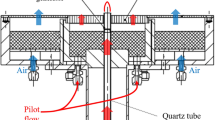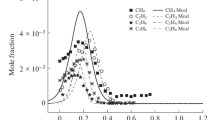Abstract
We continue the study begun in [1, 2] of chemical processes in perchloric acid—ammonia flames. We propose new channels for the reaction. Based on experimental data on the chemical structure of an ammonium perchlorate flame and flames in O2/NH3/Ar, NH3/HClO4/H2O/Ar mixtures, we estimate the rate constants for steps that have not been well studied and refine the kinetic mechanism of [1, 2]. We discuss calculation results for the chemical structure of a flame in an NH3/HClO4/H2O/Ar mixture and an ammonium perchlorate flame. We simplify the kinetic mechanism.
Similar content being viewed by others
References
N. E. Ermolin, O. P. Korobeinichev, A. G. Tereshchenko, et al., “Calculation of the kinetics and establishment of the mechanism of chemical reactions in an ammonium perchlorate flame,” Fiz. Goreniya Vzryva,18, No. 2, 61–70 (1982).
N. E. Ermolin, O. P. Korobeinichev, A. G. Tereshchenko, and V. M. Fomin, “Modeling of the kinetics and mechanism of chemical reactions in an ammonium perchlorate flame,” Khim. Fiz., No. 12, 1711–1717 (1982).
C. Guirao and F. A. Williams, “Model for ammonium perchlorate deflagration between 20 and 100 atm,” Raket. Tekhnika i Kosmonavtika (Russian translation of AIAA J.),9, No. 7, 164–179 (1971).
N. Fujii, H. Mijama, M. Koshi, and T. Asaba, “Kinetics of ammonia oxidation in shock waves,” Eighteenth International Symposium on Combustion, Waterloo, Canada, August 1980, Combust. Inst., Pittsburgh (1981), pp. 873–882.
J. Bian, J. Vandooren, and P. J. Van Tiggelen, “Experimental study of the structure of an ammonia-oxygen flame,” Twenty-First International Symposium on Combustion, Munich, West Germany, August 1986, Combust. Inst., Pittsburgh (1986), pp. 953–963.
J. W. Bozzelli and A. M. Dean, “Energized complex quantum Rice-Ramsperger-Kassel analysis in reactions of NH2 with HO2, O2, and O atoms,” J. Phys. Chem.,93, No. 3, 1058–1065 (1989).
N. E. Ermolin, O. P. Korobeinichev, and V. M. Fomin, “Kinetic mechanism of reaction of NH2 with O2 in flames containing the elements O, H, and N. I. Kinetic parameters of the reaction NH2+O2=HNO+OH,” Fiz. Goreniya Vzryva,30, No. 1, 60–65 (1994).
N. E. Ermolin, O. P. Korobeinichev, and V. M. Fomin, “Kinetic mechanism of reaction of NH2 with O2 in flames containing the elements O, H, and N. II. Estimate of kinetic parameters of steps with participitation of the species NH2O2, HNOOH, NH2O,” Fiz. Goreniya Vzryva,30, No. 4, 60–65 (1994).
A. G. Tereshchenko, “Development of the mass spectrometric probing technique for flames of condensed systems and its application for studying the chemical structure of an ammonium perchlorate flame and model systems based on it,” Dissertation in competition for the academic degree of Candidate of the Physical-Mathematical Sciences, Novosibirsk (1991).
O. P. Korobeinichev and V. N. Orlov, “Structure of a flat flame of perchloric acid mixed with ammonia and the kinetics of elementary chemical reactions in the flame,” Khim. Fiz., No. 11, 1585–1590 (1983).
J. A. Miller and C. T. Bowman, “Mechanism and modeling of nitrogen chemistry in combustion,” Progr. Energy Combust. Sci.,15, No. 4, 287–338 (1989).
W. C. Gardiner, Jr., ed., Combustion Chemistry [Russian translation], Mir, Moscow (1988).
R. L. Hatch, “Chemical kinetics combustion model of the NG/binder system,” Twenty-Third JANNAF Combustion Meeting (1986), Vol. 1, pp. 157–165.
N. E. Ermolin, O. P. Korobeinichev, L. V. Kuibida, and V. M. Fomin, “Investigation of the kinetics and mechanism of chemical reactions in a hexogen flame,” Fiz. Goreniya Vzryva,22, No. 5, 54–64 (1986).
S. Salimian, R. K. Hanson, and C. H. Kruger, “Ammonia oxidation, in shock-heated NH3−N2O−Ar mixtures,” Combust. Flame,56, No. 1, 83–95 (1984).
W. B. De More, S. P. Sander, D. M. Golden et al., “Chemical kinetics and photochemical data for use in stratospheric modeling,” JPL Publication 90-1, Pasadena, California (1990), pp. 1–217.
W. D. Chang, S. B. Karra, and S. M. Senkan, “A computational study of chlorine inhibition of CO flames,” Combust. Flame,69, No. 1, 113–122 (1987).
D. E. Jensen and G. A. Jones, “Reaction rate coefficients for flame calculations,” Combust. Flame,32, No. 1, 1–34, (1978).
V. N. Kondrat'ev, Rate Constants of Gas-Phase Reactions [in Russian], Nauka, Moscow (1970).
V. I. Gritsan and V. N. Panfilov, “Determination of the steady-state rate of thermal decomposition of gas-phase chlorine dioxide,” Kinet. Katal.,16, No. 2, 316–319 (1975).
E. T. McHale and G. von Elbe, “The explosive decomposition of chlorine dioxide,” J. Phys. Chem.,72, No. 6, 1849–1856 (1968).
Additional information
Institute of Theoretical and Applied Mechanics, Siberian Branch, Russian Academy of Sciences, Novosibirsk 630090. Translated from Fizika Goreniya i Vzryva, Vol. 31, No. 5, pp. 58–69, September–October, 1995.
Rights and permissions
About this article
Cite this article
Ermolin, N.E. Model for chemical reaction kinetics in perchloric acid-ammonia flames. Combust Explos Shock Waves 31, 555–565 (1995). https://doi.org/10.1007/BF00743807
Received:
Revised:
Issue Date:
DOI: https://doi.org/10.1007/BF00743807




